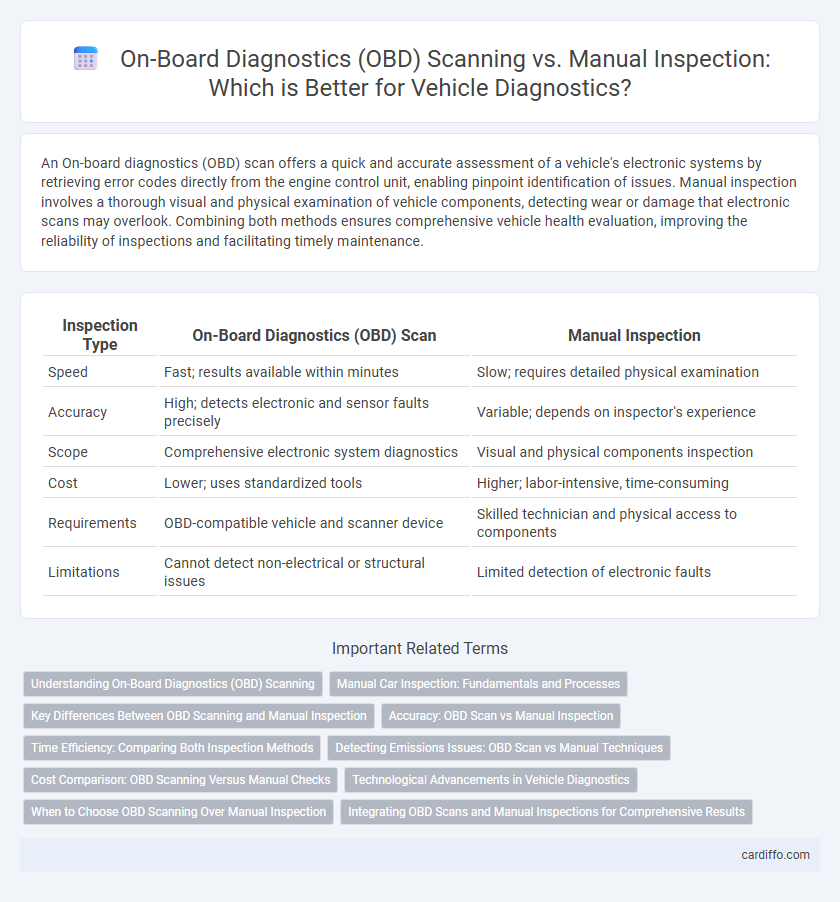An On-board diagnostics (OBD) scan offers a quick and accurate assessment of a vehicle's electronic systems by retrieving error codes directly from the engine control unit, enabling pinpoint identification of issues. Manual inspection involves a thorough visual and physical examination of vehicle components, detecting wear or damage that electronic scans may overlook. Combining both methods ensures comprehensive vehicle health evaluation, improving the reliability of inspections and facilitating timely maintenance.
Table of Comparison
| Inspection Type | On-Board Diagnostics (OBD) Scan | Manual Inspection |
|---|---|---|
| Speed | Fast; results available within minutes | Slow; requires detailed physical examination |
| Accuracy | High; detects electronic and sensor faults precisely | Variable; depends on inspector's experience |
| Scope | Comprehensive electronic system diagnostics | Visual and physical components inspection |
| Cost | Lower; uses standardized tools | Higher; labor-intensive, time-consuming |
| Requirements | OBD-compatible vehicle and scanner device | Skilled technician and physical access to components |
| Limitations | Cannot detect non-electrical or structural issues | Limited detection of electronic faults |
Understanding On-Board Diagnostics (OBD) Scanning
On-Board Diagnostics (OBD) scanning utilizes a vehicle's computer system to quickly identify and report fault codes related to engine performance, emissions, and other critical systems. This technology enables precise detection of issues that might be missed during manual inspections, such as intermittent sensor failures or pending error codes. OBD scanning enhances diagnostic accuracy, reduces inspection time, and supports proactive maintenance by providing real-time data on vehicle health.
Manual Car Inspection: Fundamentals and Processes
Manual car inspection involves a thorough visual and physical assessment of vehicle components, including brakes, suspension, tires, and fluid levels, to identify wear and potential faults. Certified inspectors follow standardized procedures such as checking for leaks, evaluating brake pad thickness, and testing suspension integrity to ensure safety and compliance with regulations. This hands-on approach detects issues that may not trigger OBD scan codes, providing a comprehensive evaluation beyond electronic diagnostics.
Key Differences Between OBD Scanning and Manual Inspection
OBD scanning provides real-time data on a vehicle's engine, emission systems, and electronic components by reading diagnostic trouble codes (DTCs) through standardized protocols, enabling quick and accurate fault detection. Manual inspection involves a visual and physical examination of vehicle parts, assessing wear, damage, and non-electronic components, often requiring more time and expert judgment. Key differences include OBD's ability to identify electronic and sensor-related issues whereas manual inspection excels in detecting mechanical problems and physical defects not captured by digital diagnostics.
Accuracy: OBD Scan vs Manual Inspection
OBD scan provides highly accurate diagnostics by electronically reading real-time data from a vehicle's computer system, enabling detection of precise fault codes and sensor malfunctions. Manual inspection relies on technician expertise to identify visible or audible issues but can miss underlying electronic or software faults not evident without diagnostic tools. Combining OBD scans with targeted manual checks maximizes accuracy in identifying both electronic and physical vehicle problems.
Time Efficiency: Comparing Both Inspection Methods
On-board diagnostics (OBD) scans significantly reduce inspection time by quickly identifying fault codes and system malfunctions within minutes, compared to manual inspections that require thorough physical checks and component testing. Manual inspections, although more time-consuming, provide a detailed assessment of mechanical and structural conditions that OBD systems may not detect. Combining OBD scanning with targeted manual inspection optimizes overall time efficiency and diagnostic accuracy in vehicle maintenance.
Detecting Emissions Issues: OBD Scan vs Manual Techniques
OBD scans provide real-time data and precise error codes from the vehicle's emission control systems, enabling rapid identification of issues such as faulty oxygen sensors or malfunctioning catalytic converters. Manual inspection, while thorough, relies on visual and physical checks that may miss intermittent or hidden emission problems detectable only by OBD sensors. Combining OBD diagnostics with manual techniques ensures comprehensive detection of emissions malfunctions, optimizing vehicle compliance with environmental standards.
Cost Comparison: OBD Scanning Versus Manual Checks
On-board diagnostics (OBD) scanning offers a cost-efficient alternative to manual inspections by significantly reducing labor time and minimizing the need for expert technicians during vehicle fault detection. The average cost of an OBD scan ranges from $40 to $100, whereas manual inspections can exceed $150 due to extensive hands-on diagnostics and potential component disassembly. Utilizing OBD scanning not only lowers inspection expenses but also accelerates the diagnosis process, enhancing overall vehicle maintenance efficiency.
Technological Advancements in Vehicle Diagnostics
On-board diagnostics (OBD) scanners leverage real-time data and advanced algorithms to quickly identify vehicle issues with high accuracy, surpassing the limitations of traditional manual inspection methods. Technological advancements in sensor integration and standardized communication protocols enable OBD systems to detect engine malfunctions, emission faults, and system anomalies efficiently. These innovations reduce diagnostic time, enhance fault detection precision, and improve overall vehicle maintenance and safety outcomes.
When to Choose OBD Scanning Over Manual Inspection
OBD scanning is ideal when quick, accurate detection of engine and emission system faults is required, especially for modern vehicles equipped with standardized diagnostic systems. Choose OBD scanning for real-time data retrieval and precise error code identification, reducing the need for extensive manual probing. Manual inspection remains necessary when physical damage or non-electronic components need evaluation beyond the scope of electronic diagnostics.
Integrating OBD Scans and Manual Inspections for Comprehensive Results
Integrating On-board Diagnostics (OBD) scans with manual inspections enhances vehicle diagnosis accuracy by combining real-time fault code data with physical component evaluation. Utilizing OBD scans allows technicians to quickly identify electronic system malfunctions, while manual inspections provide insights into mechanical wear and hidden issues not detectable by software. This comprehensive approach ensures thorough vehicle health assessments, improving maintenance effectiveness and minimizing overlook risks.
On-board diagnostics (OBD) scan vs manual inspection Infographic

 cardiffo.com
cardiffo.com